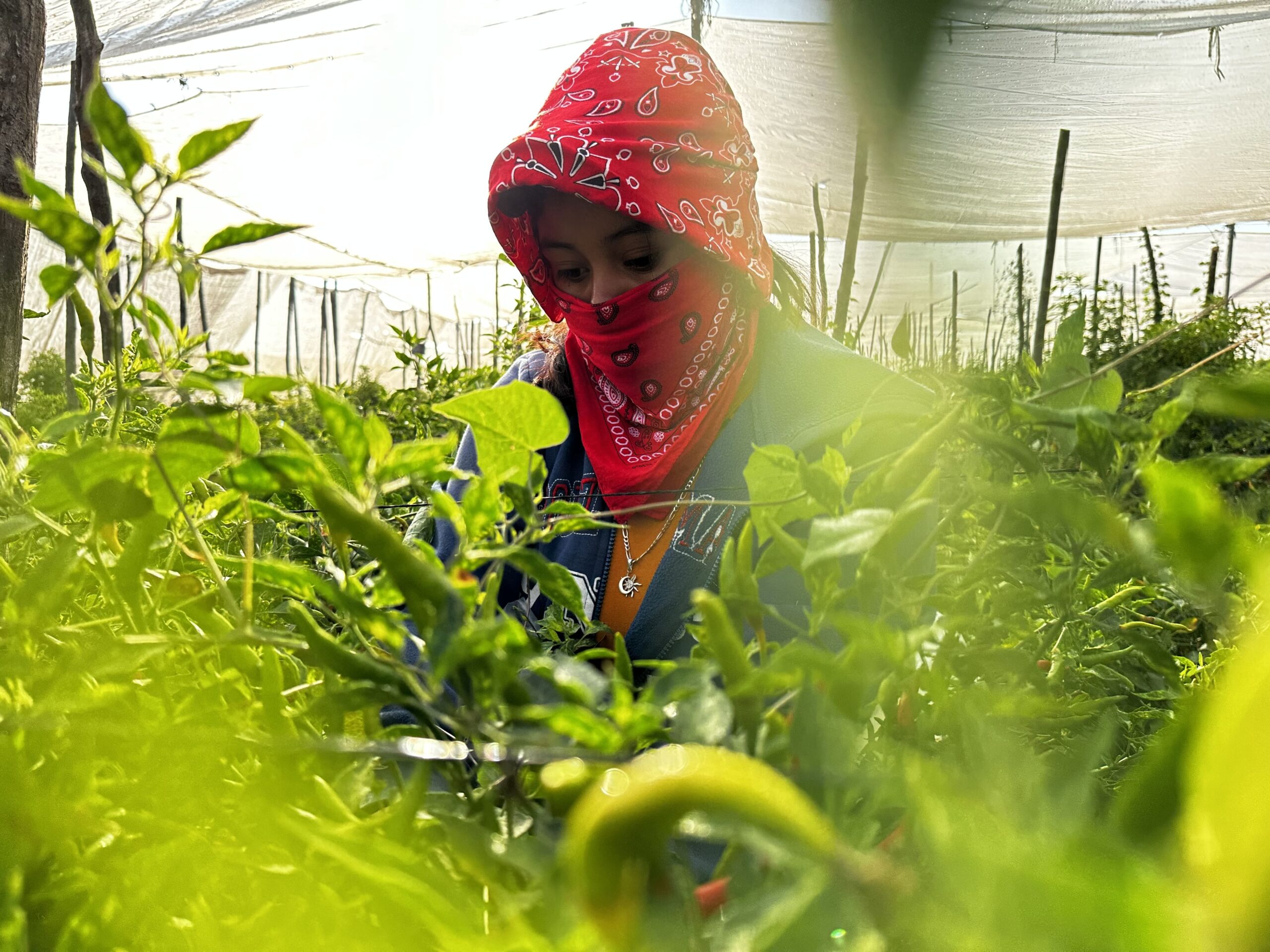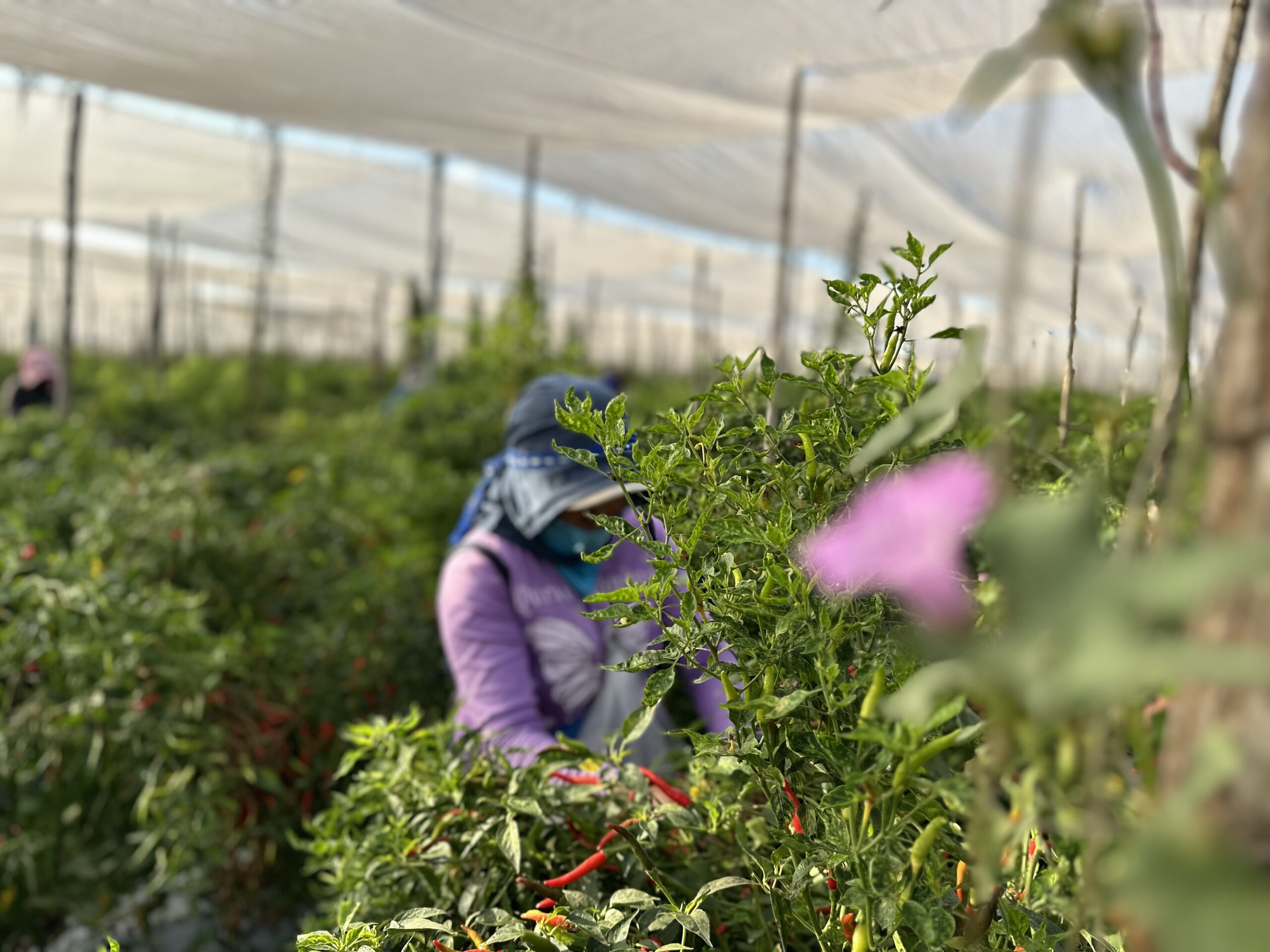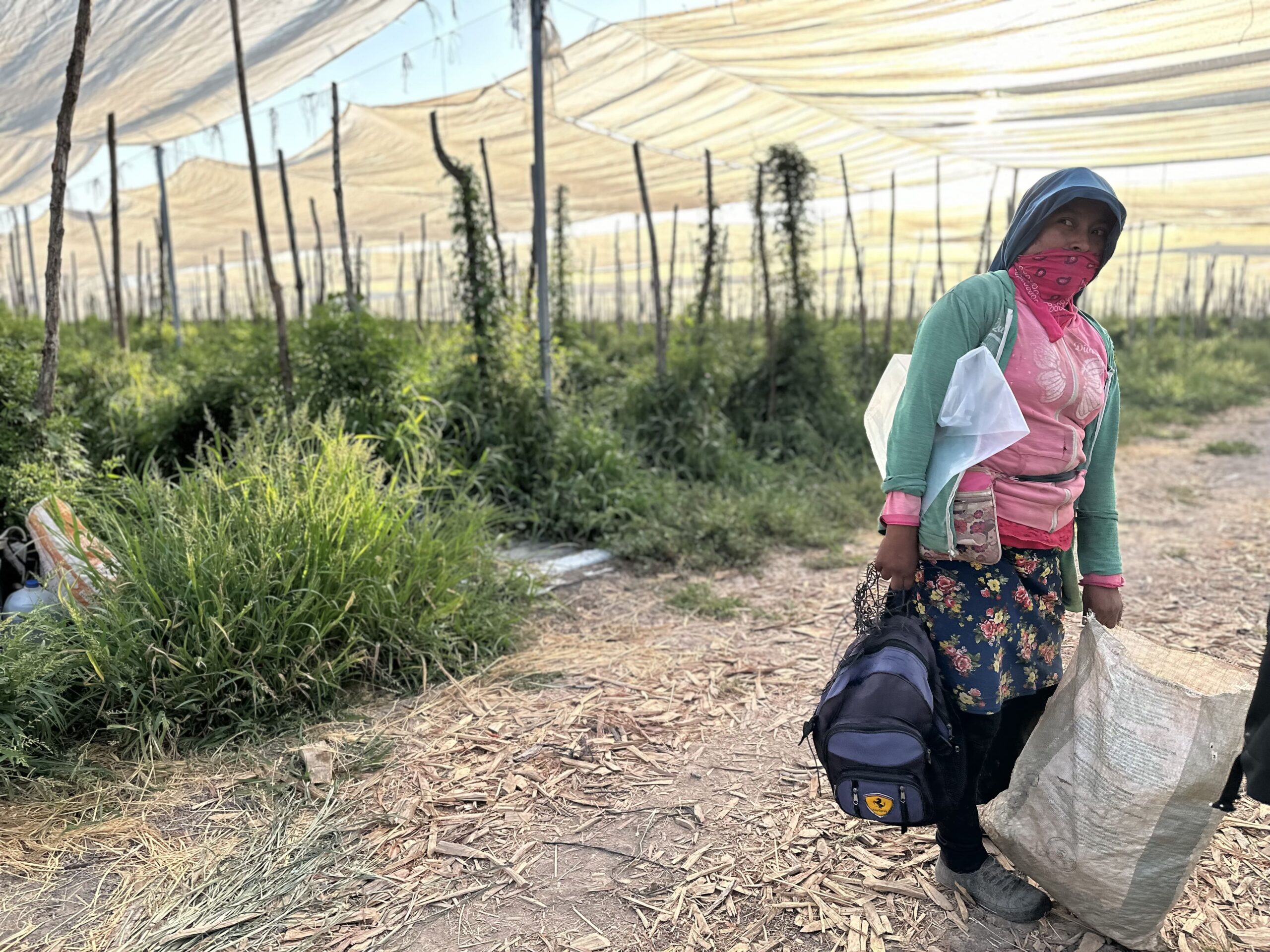By Blanca Juarez

Under the same blazing sun, women day laborers do the same work as men, but for lower wages. In Latin America, women agricultural workers share other problems: lack of access to land and an overload of unpaid care work. They also have to confront social conflict and political-military violence.
Women workers are said to be weak, but they are capable of carrying a sack of more than 20 kilos of chili peppers with a baby in the belly that can add another 10 kilos. They are compared to “Mother Earth”, but they are denied access to land, which they themselves work. According to the Food and Agriculture Organization of the United Nations (FAO), more than 20% of agricultural employment in Latin America is performed by women.
They are compared to “Mother Earth”, but they are denied access to land, which they themselves work.
They have very little recourse to justice. “They don’t talk about women’s rights on the farms,” complains Leiria Vay, a Mayan Quiché woman and member of the political leadership of the Peasant Development Committee (Codeca) in Guatemala.
“The life of women day laborers is hard,” says Abelina Ramirez, leader of the National Independent Democratic Union of Agricultural Day Laborers (SINDJA) in Mexico. Agricultural work is hard work, but “discrimination against us by the government, the companies and even our fellow workers” makes it even harder.
Wage inequality exists in every country, reflecting widespread discrimination. In Guatemala, Vay reports, only 3% of women day laborers earn a minimum wage. In Mexico, women working in the agricultural industry are paid, on average, 200 pesos a day (US$10.55). Men earn an average of 230 pesos ($12.13 dollars) per day, according to the National Institute of Statistics and Geography (INEGI).
Women in Colombia face the same injustice. There “the very patriarchal and macho context” prevents them from earning the same as men, acknowledges Daniel Camilo Arciniegas, of Resistencias, a collective of day laborers in the municipality of Cajamarca. According to the Society of Farmers, Colombian women day laborers earn on average 14% less than men.
From home to land, the work does not stop for women
At 5 a.m. it’s already late for Ofelia Hernández. “I have to make tortillas and some lunch. One part is for my husband, my two sons and me to have lunch in the fields. The other is for my other two daughters, the 11-year-old stays to take care of her three-year-old sister,” she says. At 6 o’clock in the morning, they set off to work in the furrows.
Ofelia Hernández and her family are originally from Guerrero, in the south of the country, one of Mexico’s most impoverished states, but they live only a short time at home. They spend most of the year chasing income according to the rhythm of the agricultural cycle and under the companies’ terms. The lack of job opportunities in their community forces them to migrate every year.
This year it was time to travel to Nayarit, a state in western Mexico, where her family and dozens of others were hired to harvest chile peppers. Last year it was Baja California in northern Mexico and by the end of this year it could be Guanajuato, Sinaloa or Durango.
When the day’s work in the fields ends around 4 or 5 in the afternoon, the work is not over for Ofelia Hernandez. Back at the temporary housing in Nayarit, she prepares food and relieves her 11-year-old daughter in the care of the younger one. Soon the day will be over and while the rest of the family may be resting, she washes clothes by hand, makes dinner or prepares lunch for the next day.

In Latin America, 48% of employed rural women are engaged in agriculture, livestock or artisanal fishing, according to FAO. The rest are engaged in commerce, paid domestic work or work in the health, education, tourism or government sectors.
However, the income earned by the majority in any of these occupations is insufficient to live a decent life. According to the United Nations Development Program (UNDP), 58% of rural women in Latin America and the Caribbean live in multidimensional poverty. According to the Inter-American Conference on Social Security (CISS), it is perhaps in agricultural work, an essential task to guarantee food for the population, where they have “the lowest incomes and worst living conditions in most Latin American countries”.
According to the United Nations Development Program (UNDP), 58% of rural women in Latin America and the Caribbean live in multidimensional poverty.
Day laborer families in the region face serious labor precariousness. This is especially true for women, who, in addition to working in the fields, are responsible for most of the household and unpaid care work. Given the limited coverage of care services in rural areas, such as day care centers, and the lack of balance in the distribution of care tasks between adult women and men, many girls take on part of this work.
According to Unicef, worldwide, girls between 5 and 14 years of age spend 40% more of their time cooking, cleaning and caring for family members than boys in the same age range. Taking on this responsibility takes hours away from playing, studying or resting, which are fundamental rights of children. Many of the domestic activities they perform can be dangerous for their age, for example, cooking.
“Few agricultural companies have daycare centers,” says Abelina Ramirez from Mexico. “If not all of them, at least most of them have not adopted this practice. In Guatemala, “this is far from our reality; it is not something we see in our medium-term outlook,” regrets Vay.
It is not only a matter of companies or governments providing child care services, but also of quality child care that caters to day laborer children as it does to children in the cities or from non-racialized families.
“I used to take my child to the company’s day care center, but they would send her back to me hoarse from screaming so much. They let the children cry, they don’t comfort them, they don’t hug them. One day they had taken away all her clothes, she was only in a diaper, they told me because it was too hot. It was better not to take her anymore, so now her sister takes care of her”, says Hernández. Her sister dropped out of elementary school to take care of the baby. “One of the main problems of agricultural day laborers is the lack of basic education,” says Abelina Ramírez.
Mobility is another obstacle. Shortly after the school year begins, the family has to leave home to work for six months or more in another state in the country. If there is a school nearby, they enroll their children, but girls with younger siblings are less likely to attend. Then, when the agricultural season is over, it is several weeks before the school year ends and they have to leave again.
Sexual violence against women day laborers
Starting in 2015 when the Sindicato Independiente Nacional Democrático de Jornaleros Agrícolas (SINDJA) was founded, Abelina Ramírez recalls that some women dared to speak out about sexual harassment in the fields.
“We discovered that it is very difficult to get it out in the open. With those who have dared to tell, we have given them accompaniment if they want to report it formally.” However, the case of a young woman who filed a complaint with labor authorities against one of the employers has discouraged many.
“The process took more than a year and, finally, the lawyer told us to accept the money offered by the company because the lawsuit was not going to be successful. The power of the big companies against a woman’s word is still enormous,” says Ramírez.
“In Guatemala, it is not an issue that has been properly documented,” Vay notes. A few years ago, when Codeca was conducting research on the working conditions of day laborers, they were able to observe sexual violence against women more clearly. At a meeting near the banana farms of Tiquisate, on the southern coast, “a woman leader, whom I had known for a long time but knew little about her life, spoke of overexploitation and all the problems we already know about,” recalls Vay.
Her speech progressed and she broached the topic of gender inequality and after a pause to gather strength, she said: “Compañeros, I am here with my 5-year-old daughter. Well, she is the product of a rape on the farm.” Vay froze, she could barely manage to ask her if she had filed a complaint. “She told me that she had two other children and if she denounced, the man would never give her a job again”.
In Colombia, Arciniegas says, “the feminist movement has reached the struggle of day laborers. Several women colleagues talk about sexual harassment in agricultural work, they name it, because before it was not identified”.
Criminalization and resistance

The struggles of day laborer populations in Latin America have found an echo in movements for the defense of land, territory and the environment. Also in organizations demanding social, political, labor or economic justice. However, this relationship has also led to the criminalization of their demands, which affects the most vulnerable groups, such as women.
Codeca was founded in 1992 “by indigenous comrades, who could neither read nor write, to fight for the right to land and the labor rights of agricultural day laborers”. Vay explains that “when peace was signed in Guatemala 28 years ago, we had our hopes up. We thought there would be better opportunities for indigenous peoples and peasants. But it was all to disarm the guerrillas and open the doors to the transnationals with their extractive projects.”
The government signed the Firm and Lasting Peace Agreement with the Guatemalan National Revolutionary Unity (URNG) in 1996. The armed conflict involved the Army, paramilitary groups and guerrilla groups. It lasted 36 years and left more than 200,000 people dead and disappeared. During that time, violence against women was particularly cruel.
According to Vay, the peace accords “strengthened the neoliberal system, creating a market in which money is worth more than people’s lives”. After the accords, rich families and transnational corporations were able to grab territory more easily. This left the rural and indigenous population without land, or with less fertile land. Women did not even get infertile land.
“Women who own land usually have smaller plots, of lower quality and with less secure rights,” according to FAO’s report The Voices of Rural Women in Latin America and the Caribbean in the Face of Multidimensional Crises. Depending on the country, in the region women own between 8% and 30% of the land. Vay explains that, after the dispossession in Guatemala, one of the few ways to earn an income was to work on the large farms favored by the neoliberal model in the country, where wages are low, especially for women.
Thousands more have crossed the border into Mexico and work as day laborers in Chiapas and, in recent years, in the fields of Jalisco, Michoacán and Guanajuato. Others have gone to the United States.
In Mexico, of the more than 5 million people with deeds to ejido or communal lands, only 27% are women, according to the National Women’s Institute (Inmujeres). “It is difficult for women day laborers to gain access to land tenure. On the other hand, this is made easier for large companies, especially foreign ones. “Sometimes it seems that we are destined to always work on other people’s land,” reflects the activist originally from the state of Oaxaca, in southern Mexico. .
“I joined the struggle for labor rights after the work stoppage in the San Quintín Valley, Baja California, in 2015,” says Ramírez. “We lived in truly inhumane conditions, people didn’t have bathrooms or time to eat. Wages were miserable, but even worse for women. Sexual harassment by the mayordomos (foremen) and even by the employers or managers of the day laborers was the bitter bread of every day.”
In forming the union, many women, like Abelina Ramirez, demanded of their fellow workers that the struggle for labor rights would have to take into account the voice of the day laborers. In the past, armed political movements, such as those led by Genaro Vázquez and Lucio Cabañas in Guerrero, and the September 23rd Communist League in various regions of Mexico in the 1970s incorporated the demands of agricultural day laborers, but did not specifically address the needs of women. Their real or presumed link to these movements was taken as a pretext by the Mexican state and the companies to criminalize the demands of the day laborers.
“The organization of oppressed populations will always be discredited,” says Arciniegas. In Cajamarca, Colombia, “when we landless people began to become active again a few years ago, we were associated with guerrilla movements” of the armed conflict that the country has been experiencing since 1960. In this way, the neoliberal governments, states the activist, sought to undermine their demands and not attend to them. “Despite the fact that there are some lands that could be destined for peasant families, this is unlikely to happen,” says the young man.
In Cajamarca, day laborer families have also organized to prevent the operation of an open-pit mine. “Our struggle today is very diverse, and we are increasingly understanding that what we achieve will have to be with women and for women,” says Arciniegas.
Abelina Ramírez concludes: “Women in the fields have been made invisible. So has our work in the home and in social struggles. But we day laborers work the land, we grow food, we raise people and it is time for all this to be heard and recognized”.
The processes of organizing women day laborers in Mexico, Guatemala, Colombia and, in general, in Latin America have advanced at different rates and in different directions. They have been related to social movements, land defense and peasant rights.
Ramírez states that unionism is one of the forms of organization that can bring the most benefits to women day laborers. At least, that has been her experience. After the 2015 strike in San Quintín, Baja California, in Mexico, the working conditions of agricultural workers had not improved, so SINDJA carried out a caravan from that Baja California in the north of the country to Mexico City.
“That was when I began to participate publicly, carrying the voice of the women day laborers not only in San Quintín, but throughout the country. It was when I began to work more intensely, more aggressively. It changed my life, my way of thinking about the companies, the workers. And it was when I discovered the importance of disseminating women’s rights,” says the Mexican activist.
In Colombia, the Political Advocacy Platform of Colombian rural women succeeded in having some of their labor demands included in the National Development Plan 2022-2026. The government project contemplates the creation of measures to improve women’s working conditions, which “implies spaces free of violence and discrimination, a reduction in the gender wage gap, the harmonization of personal life and an increase in their overall wellbeing”.
And in Guatemala, the Peasant Development Committee (Codeca) has broadened its demands, proposing the creation of a Plurinational State. “We have fought hard, but our living conditions have not changed. We will continue to fight for land and labor rights, but the problem is bigger: it is structural. It’s the power structures, it’s the system itself, which doesn’t allow things to work,” Vay explains. They have integrated “networks of women, professionals, students, vendors and other groups” to form the Popular and Plurinational Constituent Assembly, from where this Plurinational State will emerge. “Let the people be the ones to build their own path,” she says.



